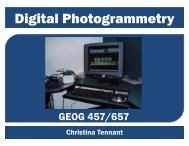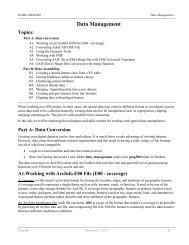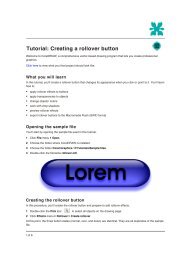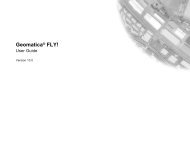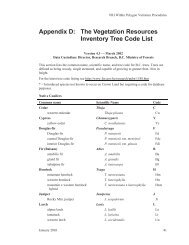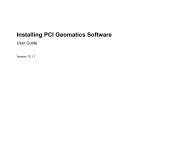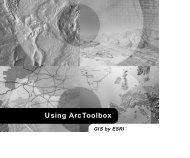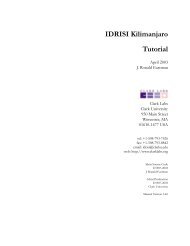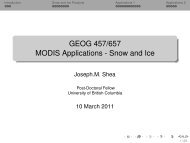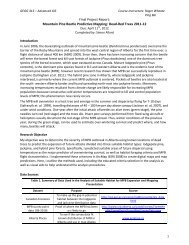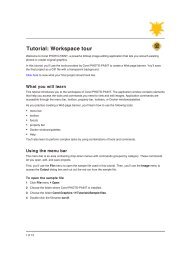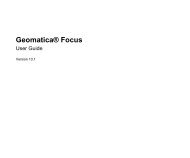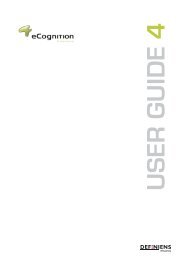Understanding Map Projections
Understanding Map Projections
Understanding Map Projections
You also want an ePaper? Increase the reach of your titles
YUMPU automatically turns print PDFs into web optimized ePapers that Google loves.
UNIVERSAL T RANSVERSE MERCATOR<br />
DESCRIPTION<br />
Also known as UTM.<br />
The Universal Transverse Mercator system is a<br />
specialized application of the Transverse Mercator<br />
projection. The globe is divided into 60 north and<br />
south zones, each spanning six degrees of longitude.<br />
Each zone has its own central meridian. Zones 1N<br />
and 1S start at -180° W. The limits of each zone are<br />
84° N and 80° S, with the division between north<br />
and south zones occurring at the equator. The polar<br />
regions use the Universal Polar Stereographic<br />
coordinate system.<br />
The origin for each zone is its central meridian and<br />
the equator. To eliminate negative coordinates, the<br />
coordinate system alters the coordinate values at the<br />
origin. The value given to the central meridian is the<br />
false easting, and the value assigned to the equator<br />
is the false northing. A false easting of<br />
500,000 meters is applied. A north zone has a false<br />
northing of zero, while a south zone has a false<br />
northing of 10,000,000 meters.<br />
PROJECTION METHOD<br />
Cylindrical projection. See the Transverse Mercator<br />
projection for the methodology.<br />
LINES OF CONTACT<br />
Two lines parallel to and approximately 180 km to<br />
each side of the central meridian of the UTM zone.<br />
LINEAR GRATICULES<br />
The central meridian and the equator.<br />
Distance<br />
Scale is constant along the central meridian but at a<br />
scale factor of 0.9996 to reduce lateral distortion<br />
within each zone. With this scale factor, lines lying<br />
180 km east and west of and parallel to the central<br />
meridian have a scale factor of one.<br />
LIMITATIONS<br />
Designed for a scale error not exceeding 0.1 percent<br />
within each zone. Error and distortion increase for<br />
regions that span more than one UTM zone. UTM is<br />
not designed for areas that span more than a few<br />
zones.<br />
Data on a spheroid or an ellipsoid cannot be<br />
projected beyond 90 degrees from the central<br />
meridian. In fact, the extent on a spheroid or<br />
ellipsoid should be limited to 15–20 degrees on both<br />
sides of the central meridian. Beyond that range,<br />
data projected to the Transverse Mercator projection<br />
may not project back to the same position. Data on a<br />
sphere does not have these limitations.<br />
USES AND APPLICATION<br />
Used for United States topographic quadrangles,<br />
1:100,000 scale.<br />
Many countries use local UTM zones based on the<br />
official geographic coordinate systems in use.<br />
Large-scale topographic mapping of the former<br />
Soviet Union.<br />
PROPERTIES<br />
Shape<br />
Conformal. Accurate representation of small shapes.<br />
Minimal distortion of larger shapes within the zone.<br />
Area<br />
Minimal distortion within each UTM zone.<br />
Direction<br />
Local angles are true.<br />
Supported map projections• 93



